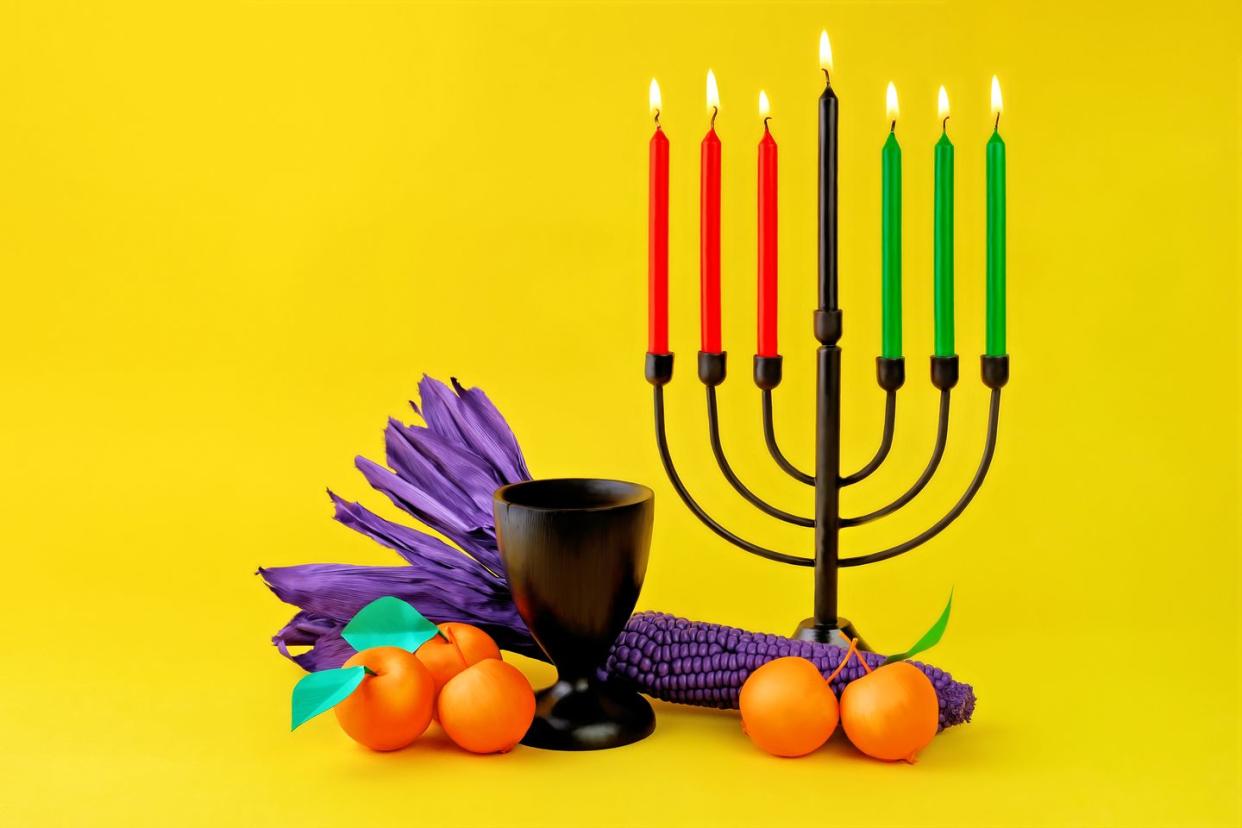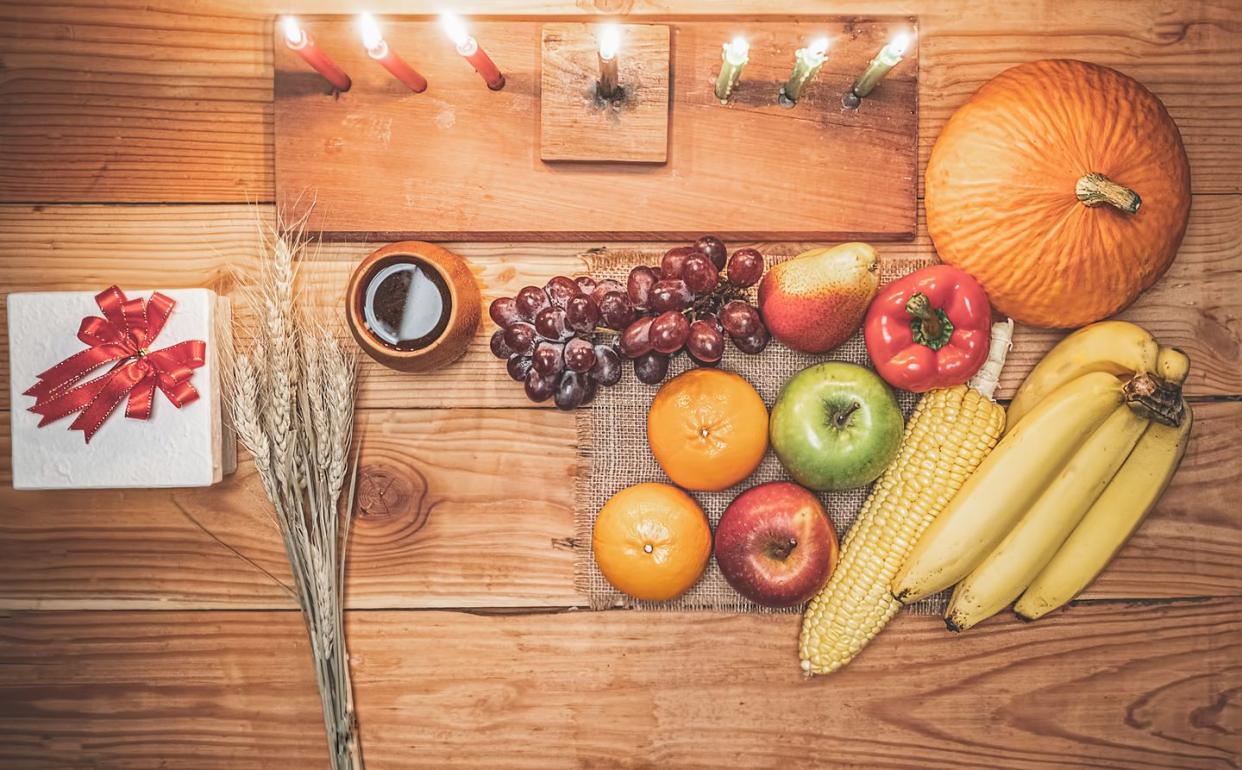Celebrate Kwanzaa By Honoring These Meaningful Traditions
"Hearst Magazines and Yahoo may earn commission or revenue on some items through these links."
Observed annually between December 26 and January 1, Kwanzaa draws from several African harvest festivals and blends elements of continental African culture, African American history and traditional African values.
The holiday was created by Dr. Maulana Karenga in 1966 as a way to encourage African American families to reconnect with and appreciate their unique heritage. As Kwanzaa gained prominence in the United States and throughout the African diaspora, its profound principles have become a warm invitation to promote unity, create cherished memories, encourage purpose, honor African roots and embrace the rich heritage and values Kwanzaa brings.
“The love, food and camaraderie were fantastic,” says Baba Imamu Kuumba, who serves as the treasurer of the Universal Negro Improvement Association and African Communities League (UNIACL) in Washington D.C, of his first Kwanzaa celebration in 1972. “People shared their ideas about a lot of things that affect our people, locally, nationally and internationally.”
Kwanzaa also emerged as a contrast to the increased consumerism surrounding traditional holidays, says John El-Badr, the director of the Heritage Gallery of the Thurgood Marshall Center in Washington, D.C. For example, El-Badr says he grew up in a Black community where his grandparents gave children fruits and nuts as Christmas gifts because that’s all they could afford.

“Kwanzaa was a blessing to me because it wasn’t commercial,” he says. “During Kwanzaa, if you give a gift, it has to be hand-made.”
Although Kwanzaa traditionally is celebrated by families with African roots, any family can celebrate the spirit of Kwanzaa this holiday season and beyond. Here are the traditions, symbols and principles you need to know about the celebration.
What is the history of Kwanzaa?
Kwanzaa emerged in mid-1960s, after the Watts Riots in Los Angeles. Dr. Maulana Karenga, professor and chairman of Black Studies at California State University, Long Beach, developed the celebration to build solidarity within the African American community and a stronger connection to African history. He founded US, a cultural organization, and crafted Kwanzaa to reflect “first fruits” celebrations found in various countries in Africa.
The word Kwanzaa comes from the phrase “matunda ya kwanza” which means “first fruits” in Swahili.
While Kwanzaa has spread to various countries around the globe including France, England and Brazil, Dr. Karenga’s reputation has remained sullied by an assault charge from the early 1970s. Speaking to Karenga’s past and the celebration of the holiday, Dr. Huberta Jackson-Lowman, a retired professor in the Department of Psychology at Florida A&M University, says, “We can appreciate gifts and understand that they come from imperfect people.”
Although a small percentage of the African American population actively celebrates Kwanzaa, interest in the holiday is deepening as more African Americans are exploring their family traditions and lineage through sources like African Ancestry, which boasts “the industry’s largest and most comprehensive database of over 30,000 indigenous African DNA samples.”
What are the 7 symbols of Kwanzaa?
Kwanzaa centers culture and community, and is rich in symbolism. The visual focal point of the celebration is Mkeka, a mat that is accentuated with symbols.
Mkeka, the mat, symbolizes history and tradition that serve as the foundation of the community.
Mazao, the crops, represent the first fruits that are brought to the community.
Kikombe cha Umoja, the unity cup, represents the foundational principle of unity.
Muhindi, the corn, symbolizes children who represent the future. Each ear of corn is meant to represent the number of children in the household. If they are none, at least two are placed on the mat.
Kinara, the candle holder, represents the African ancestors that uphold the community.
Zawadi, the gifts, tangibly represent the commitments participants make during the celebration. Children are usually the recipient of the gifts which include a book and a cultural heritage present.
Mishumaa Saba, the seven candles, represent seven principles that particularly undergird and uplift communities of African descent.

How is Kwanzaa celebrated?
Dr. Jackson-Lowman summarizes the holiday as “coming together to celebrate who we are and passing down our culture to our children.”
Although all Kwanzaa celebrations are filled with food, family and the lighting of the Kinara (candleholder), how communities celebrate the holiday varies. These diverse communal traditions are commonly filled with traditions including African drumming, dancing, inspirational messages, storytelling, learning about heritage, crafts and of course — a feast. Children can get involved with the ceremonial holiday tasks, like lighting the kinara and displaying the symbols on the mkeka.
Kwanzaa is not a religious holiday but a spiritual celebration that celebrates seven principles known as the Nguzo Saba.
Each principle is highlighted on one of the seven days of the holiday, and relates to the Mishumaa Saba:
Day 1: Umoja (Unity)
On the first day of Kwanzaa, December 26, a child or adult lights the black candle in the center of the Kinara to emphasize Umoja (Unity). Unity is at the heart of community, and day one invites celebrants to “strive for and maintain unity in the family, community, nation and race.” This day stresses that unity is intergenerational and spans continents.
Day 2: Kujichagulia (Self Determination)
Self-determination, or Kujichagulia, is the focus of the second day of Kwanzaa on December 27. The purpose of Kujichagulia is “to define ourselves, name ourselves, create for ourselves and speak for ourselves.” On this day, the first red candle (to the left of the black candle) is lit.
Day 3: Ujima (Collective Work and Responsibility)
Day three of Kwanzaa focuses on Ujima (Collective Work and Responsibility). Its goal is “to build and maintain our community together and make our brother's and sister's problems our problems and to solve them together.” In the spirit of unity, Ujima asks the community to take responsibility for individual members’ obstacles. The community works endlessly for the benefit of all. The first green candle (to the right of the black candle) is lit on this day, December 28.
Day 4: Ujamaa (Cooperative Economics)
Ujamaa stresses that members of the community must “build and maintain our own stores, shops and other businesses” and “profit from them together.” Building and supporting Black-owned businesses is central to Ujamaa. The second red candle is lit on this day, December 29.
Day 5: Nia (Purpose)
The fifth day of Kwanzaa, December 30, focuses on Nia in order “to make our collective vocation the building and developing of our community in order to restore our people to their traditional greatness.” Nia emphasizes that having an individual purpose or goal is not enough. Rather, each person must commit to the larger goal of restoring and building up the community. On day five, the second green candle is lit.
Day 6: Kuumba (Creativity)
Kuumba encourages creativity that serves the collective. Day six asks celebrants “to do always as much as we can, in the way we can, in order to leave our community more beautiful and beneficial than we inherited it.” Kwanzaa itself is an example of Kuumba in action. The third red candle is lit on this day, December 31.
Day 7: Imani (Faith)
The final green candle is lit on day seven, January 1, and gifts — often handmade — are given. The week-long celebration ends appropriately with Imani, which is “to believe with all our heart in our people, our parents, our teachers, our leaders and the righteousness and victory of our struggle.”
What activities should I do on Kwanzaa?
Fay Cobb Payton, Ph.D, a consultant, speaker and Professor Emerita Information Technology and Analytics, and her family began celebrating Kwanzaa to preserve and connect to their core families, whom they lived far away from. “Celebrating Kwanzaa provided community for us to make connections and for our children to see other Black families celebrating Kwanzaa," she says.
Here are some things you can do to celebrate:
Set a Kwanzaa table. Make your Kwanzaa table the central focus for your celebrations. Its dazzling symbolism is meaningful and essential to celebrating the holiday. Need ideas? Seven Symbols of Kwanzaa is a New Jersey-based business that sells Kwanzaa accessories, gifts, candle sets, gifts, and more.
Light candles. There is something incandescent about flickering lights against the night sky. Kwanzaa is celebrated over seven nights, with one candle being lit each night. Begin with the black candle in the center, and then alternate lighting a red and green candle each evening to represent each of Kwanzaa’s seven principles. Discuss the principle it symbolizes and how it can apply to your family’s life.
Reflect and set goals. During Kwanzaa’s seven days, take time as a family to reflect on each daily principle – unity, self-determination, collective work, cooperative economics, purpose, creativity, and faith. Discuss how you can incorporate them into your daily lives. Set goals and intentions for the coming year based on these principles.
Learn your family’s history. The collective acts of defining, naming, and learning about one’s history are central components of Kwanzaa. Giving and making books, especially to children, during Kwanzaa are ways community elders pass on their distinct family history and heritage to younger generations.
What do you eat during Kwanzaa?
Savor African-inspired dishes. Taste the world on your plate by trying African-inspired dishes, some of which can be found in your local grocery store aisle. For example, AYO Foods sells West African dishes like jollof rice, cassava leaf stew and egusi seed soup at select Target and Fresh Market stores.
Explore regional African flavors. If you like to cook at home, try recipes from regional cookbooks like The East African Cookbook by Shereen Jog, Saka Saka: Adventures in African Cooking South of the Sahara by Anto Cocagne and Aline Princet or Vegan Africa: Plant-Based Recipes from Ethiopia to Senegal by Marie Kacouchia to start.
Discover and try family recipes. Many American Kwanzaa recipes mirror modern Southern cooking. Shrimp creole, Jamaican “Jerk” chicken, mac-n-cheese, skillet cornbread and Black-eyed peas are among the best Kwanzaa dishes.
Cherish Caribbean and Spanish foodways. Kwanzaa’s global influence can be tasted by combining African, Spanish and Caribbean flavors to make fried plantains. Maduros, also known as fried plantains, are caramelized and crispy on the outside while retaining its sweet yummy texture inside. Pair the fried plantains with rice and beans and Jamaican jerk chicken for a hearty meal.
How to celebrate the spirit of Kwanzaa year-round
Kwanzaa is an annual, weeklong gathering. Everyone can honor its principles throughout the year. Here are a few straightforward activities to start.
Take a family field trip. Travel along the “United States Civil Rights Trail,” that consists of a series of landmarks (churches, courthouses, schools, and museums) across 15 states that played an essential role in advancing social justice in the 1950s and 1960s.
Plan or attend a family reunion. Usually held during the summer, family reunions are wonderful opportunities for multi-generations and different branches of the family tree to get to know each other and have fun. It’s also a fantastic chance to get to know elderly family members who contain a wealth of family history and stories.
Support Black-owned businesses. Embody Ujamaa by supporting local, Black-owned businesses.
Listen to Black podcasts. African American podcasts address local and national issues like education, the economy, and health care through a distinct lens. They offer conversation and solutions. Among some of the most popular podcasts are: While Black, Black History Year, LeVar Burton Reads, Therapy for Black Girls, and The Mama’s Den.
You Might Also Like
